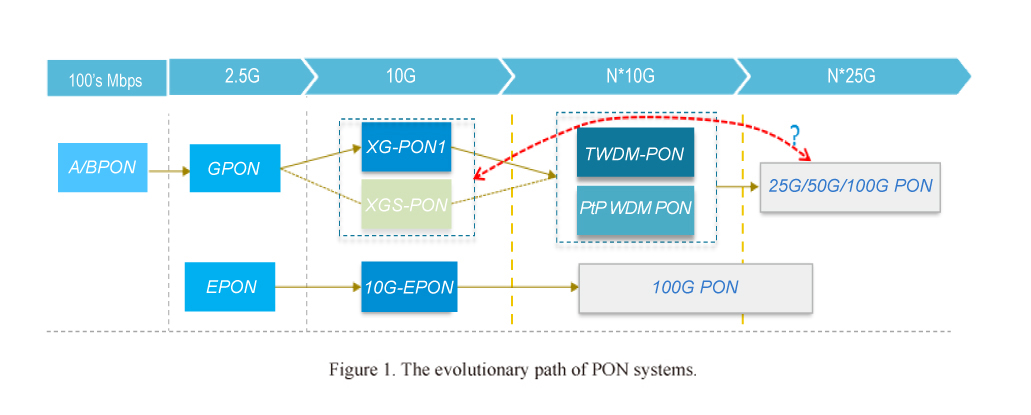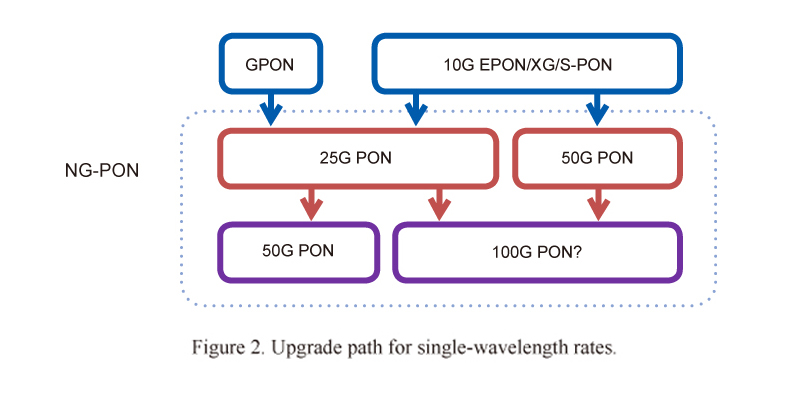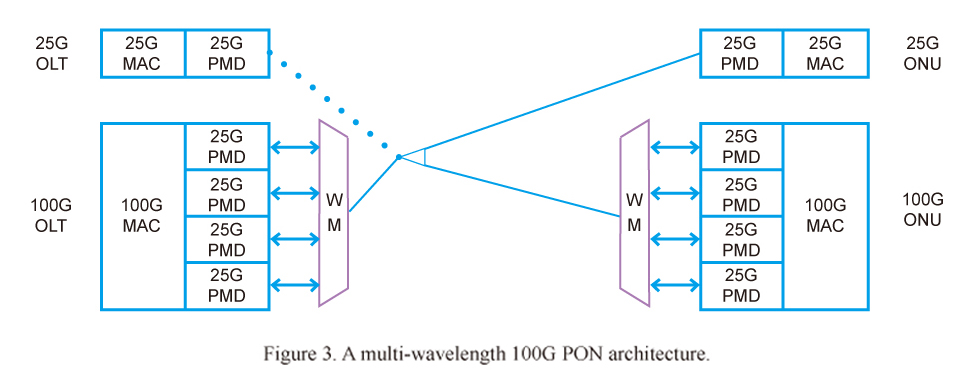The Evolutionary Path of NG-PON
Currently, the next-generation PON (NG-PON) refers to the new-generation PON that is expected to emerge after 2017. The evolution of PONs from different generations based on bit rates on a fiber is defined in both IEEE and ITU-T. ITU-T SG15 defines A/B PON, GPON, XG/S PON and NG-PON2, while IEEE defines EPON and 10G-EPON (Fig. 1).

Advances in broadband technology are driven by an increasing number of smart connected devices, the emergence of video streaming services including 4K/8K and AR/VR, 4G/5G mobile fronthaul/backhaul services, and industrial internet services. It is therefore necessary to start with the service requirements to discuss NG-PON. By analyzing core service requirements, solutions for launching new PON technology at the expected time can be worked out to support the development of broadband services.
Basic Requirements
Application Scenarios
NG-PON has basically the same applications as FTTx and can also offer 5G fronthaul and backhaul as a potential service. When PON is used to carry mobile services, its requirements for fronthaul and backhaul are different. Fronthaul requires high bandwidth (more than 25G for 5G bearer network), so using WDM-PON to support point-to-point link has become a major concern. As for the backhaul with small data traffic, TDM-PON can be used, but the delay requirement must still be satisfied. This paper focuses on the evolutionary path of NG-PON based on TDM-PON.
Deployment Time
EPON and GPON have been widely deployed around the world since 2010. After years of fiber-optic infrastructure construction, many countries are actively involved in FTTH deployment. Optical access is now basically provided via TDM in the uplink and broadcasting in the downlink. With the service expansion and user's growing demands for bandwidths, 10G EPON and 10G GPON have also been deployed on a large scale since 2016.
Conventionally, each generation of PON technology has 7-8 years life. For operators who have deployed 10G PON, their NG-PON may be deployed in around 2025. Operators who are deploying GPON and may not have been prepared for 10G PON may consider deploying their NG-PON in 2-3 years. Therefore, considering the demands of NG-PON deployment in 2-3 or 7-8 years, it is necessary to form two generations of PON subsystems based on the same optical-layer rates.
Compatibility with Legacy Networks
Legacy networks in this paper refer to the deployed optical access networks that include EPON, GPON, 10G EPON and 10G GPON (XG/S-PON). A general consideration in network upgrade is the compatibility with at least one generation of legacy PON systems. Operators in China started a large-scale deployment of 10G EPON and XG/S-PON in 2017, while European operators are still deploying GPON and MSOs in North America have begun to deploy 10G EPON. So far, it is unlikely that operators will upgrade directly from 1G EPON to NG-PON without going through 10G EPON. Therefore, the evolutionary path will most probably be from 10G EPON and XG/S-PON or GPON to NG-PON.
Different operators may choose different paths for evolution. Their choices are affected by wavelength planning and the selection of next-hop rates. When designing a NG-PON system, it is necessary to consider operator needs to give a unified solution.
Evolutionary Path
In terms of cost and technical maturity, single-wavelength 25G PON will be a feasible option for post-10G PON in around 2022. When combined with high-order modulation techniques such as PAM4, duobinary and DMT, 25G PON can support single-wavelength 50Gbit/s data rates.
Data rates on a single fiber can be improved by two schemes: single-wavelength rate boosting and multi-wavelength overlapping. The two schemes have their own advantages and disadvantages in terms of cost and technical feasibility. The evolutional path to NG-PON is determined by a number of factors, including the comparison of two schemes and the coexistence with legacy networks.
Single-Wavelength Rate Boosting Scheme
Now 25G optoelectronic devices used in data centers are increasingly maturing, and 25G is becoming a standard rate for NG-PON. In January 2016, the IEEE P802.3ca Task Force was set up to develop the standard for NG-PON (25G/50G/100G PON), with the target of finalizing it in about 2018. ITU-T also started research into single-wavelength 10G+ PON in Q2 2016. These standards and researches will make broadband access evolve toward higher bandwidth, allowing users to enjoy an average bandwidth of over 1G.
Considering the data rate, cost and technical difficulty for single-wavelength PON, non-return to zero (NRZ) is a simple coding solution for 10G+ PON, but it is not suitable for data rates above 25G (e.g. 50G). To address this issue, high-order modulation techniques such as PAM4, duobinary and DMT are being extensively researched. It is commonly agreed that NRZ can basically meet the requirements of most optical power budget for 25G PON for it is simple to implement and has high receive sensitivity. However, more analysis needs to be made on 50G PON, as there is still no clear conclusion about whether NRZ or high-order modulation is used.
In the single-wavelength rate boosting scheme, NG-PON can coexist with legacy networks in WDM mode. The single-wavelength PON system is simple to implement, but its data rates shall be boosted according to evaluations by operators. If upgrading the deployed 10G PON, operators have to consider more about its 7-8 years of lifecycle and that by around 2025, the next hop to 50G will be an appropriate rate. If the upgrade is from GPON and starts in about 2021, operators can skip 10G and directly choose 25G, because there is no clear conclusion about the use of 50G in 2-3 years in terms of cost technical feasibility. The research shows single-wavelength 100G within 7-8 years may not meet application requirements of TDM-PON in terms of technology and cost (Fig. 2).

Multi-Wavelength Overlapping Scheme
In some cases, boosting single-wavelength rates may involve great technical difficulties and high implementation costs. To meet near-term high bandwidth requirements, operators can adopt the multi-wavelength technology that can achieve high speed access with relatively low line rates. NG-PON2 defined by ITU-T SG15 uses more than four wavelengths. When each wavelength supports a rate of 10G, the rate of a single fiber can reach 40G or beyond. The IEEE P802.3ca Task Force is also discussing a 100G EPON solution based on the multi-wavelength technology. The difference between 100G EPON and NG-PON2 is that no tunable optical modules but multi-wavelength bonding is used in 100G EPON to achieve a rate of 100G with a single fiber. However, the following needs to be considered for 100G EPON:
● Wavelength plan is difficult for multiple wavelengths, especially for compatibility with legacy networks as available optical spectrum resources are limited.
● The multi-wavelength system can use tunable optical technology to make the ONU colorless, but the cost is high. The system can also use multi-wavelength bonding to boost rates, which, however, involves complex technology and optical power budget issues caused by insertion loss because of wavelength multiplexing and demultiplexing.
Since there is no specific commercial multi-wavelength PON system to verify its availability and economy, multi-wavelength overlapping technology is still cautiously deployed. Tunable optical technology would be a feasible choice for NG-PON if it can significantly reduce the cost.
A multi-wavelength 100G PON architecture is illustrated in Fig.3. Based on the architecture, the 100G EPON solution adopts single-wavelength 25G and can achieve a maximum access rate of 100G over a single ONU by using the multi-wavelength bonding technology. The solution can also support gradual upgrade from 25G to 100G. Four 25G wavelengths are bound to support 100G. As a result, a wavelength multiplexer (WM) must be added for multiplexing and demultiplexing. This will cause significant loss (6dB) and thus pose a severe challenge to already tight optical power budget. To achieve 50G, two 25G wavelengths are needed, but there is still debate over whether one single-wavelength 50G or two 25G wavelengths are used. It would therefore be a high risk to use the multi-wavelength PON system in TDM mode.

Summary
Advances in PON technology have gradually boost fiber-optic bandwidth, making it possible to provide flexible bandwidth solutions over shared fibers. NG-PON will continue to serve as an economical, high-speed optical access technology for broadband network construction.
Single-wavelength 25G PON is an important technology for evolution to NG-PON. 25G optical modules can reuse the optical industry chain for data center networks with 25G baud rate interfaces. Low cost and technical maturity are core drivers for evolution to NG-PON.
The single-wavelength rate boosting scheme is a preferred choice, but with the contradiction among bandwidth need, technical fulfillment, and cost reduction, multi-wavelength technology can also be a solution in a certain period of time. The evolution to NG-PON needs to further balance bandwidth need, technology and cost. The continued research in this area will offer effective support for the choice of NG-PON technology.